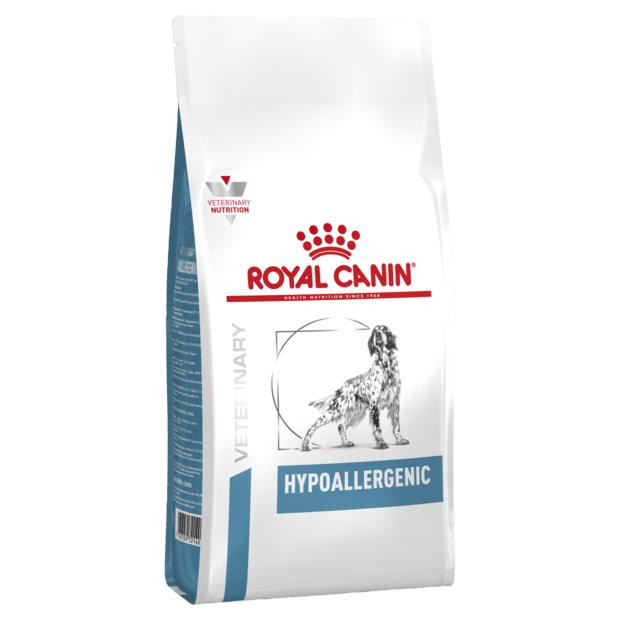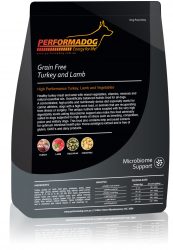Royal Canin Hypoallergenic Dog Food Review

Your dog has a dietary sensitivity, or “allergy”, and your vet has recommended Royal Canin Hypoallergenic dog food to fix the problem?
But does it fix the problem?
What is the real problem your dog has?
It may not be as complicated as you think.
If you haven’t read the ingredients of Royal Canin Hypoallergenic, then I think you’ll be surprised… or a little miffed.
Royal Canin Hypoallergenic review
What the marketing says
When your vet recommends a brand it’s easy to trust their advice as a professional, and trust the brand without considering what you’re actually paying for. I was guilty of this myself almost 2 decades ago, and these products haven’t changed much since.
You would also expect a brand like Royal Canin, especially the “Veterinary” range, to be backed by bucket loads of science and research. In reality we can use some basic facts about our dogs to raise some ominous questions, and it doesn’t take much digging.
You may be wondering why your vet would recommend such a brand if it wasn’t “good”, but there are simple reasons for this. A key reason is they’ve seen it “work”. Royal Canin Hypoallergenic works – it will alleviate your dog’s symptoms – but why.
Don’t worry, I’ll tell you why shortly. Once you know, finding a suitable dog food will be easier than you think – I’ve known this to be the case on countless occasions. After all, you don’t want to be locked in to an expensive veterinary dog food, do you?
To start with, a better term to “allergy” is a food “sensitivity”. If your dog has been showing symptoms of a food sensitivity then it is very likely something in your previous dog food. Is this something you’ve considered?
It’s quite possible the ingredient wasn’t appropriate for a dog anyway, which is often true for many dry dog foods.
Let’s take a look at the ingredients of Royal Canin Hypoallergenic.
What the ingredients really say
You may consider your dog an omnivore, because that’s what we’re often told. Many people these days consider them carnivores – they’re from the Order Carnivora after all. Wherever you believe your dog sits on this scale doesn’t really matter, as I’m sure you know they love meat.
The main ingredient in Royal Canin Hypoallergenic is rice. Not nutritious brown rice either, but bog standard cheap white rice.
Rice probably doesn’t strike you as a staple ingredient for your meat-eating pooch, but the benefit to your dog is it’s not “allergenic”.
But what about protein? The stuff that keeps your dog healthy, supporting their muscles and organ health?
This isn’t from meat either, instead being hydrolysed soya protein isolate, so processed soya. Hydolysed means the soya protein has been broken down using hydrolysis to make it more digestible, but you have to question the benefit to your dog of processed soya protein over meat proteins which are by default easy to digest.
These two ingredients will be most of the food. Does that make you wonder why you’re paying so much for rice and soya for your dog?
But it’s “science”, so you still trust it. Those clever boffins at Royal Canin know what they’re doing, right?
Perhaps it’s more about profit margins than your dog?
Did I mention Royal Canin is made by Mars, one of the world leaders in profiting from consumers?
The remaining “main” ingredient is animal fat, which although better for a dog is very ambiguous. Fat from what animals?
Compare these ingredients with other premium dog foods and you may wonder what you’re paying for.
What you really should consider
Let’s get back to your old dog food. Did it contain wheat, cereals, cereal by-products? If it did, I bet that’s your problem.
Wheat is problematic for dogs as they struggle to digest it. Cereals are usually worse, and will likely be wheat anyway. As for by-products of wheat… well, you can guess.
Chicken is also a common cause of allergies and sensitivities in dogs, or beef, or perhaps lamb. Your dog may only react from those meat proteins cooked, or sometimes only raw.
Chicken is the trickiest sensitivity because it’s in most dry dog foods regardless of “flavour”. Even a “Beef” formula may contain chicken, chicken fat, or even “animal fat” can be chicken. Confusing, isn’t it?
Don’t worry, there’s some great recommendations on the hypoallergenic dog food page which don’t contain any of the above ingredients. Limited ingredient dog foods may also be a good starting point, as these are designed for this specific reason.
Your best way forward is to find out exactly what is causing the reaction in your dog. Vital information!
Related: Hypoallergenic dog foods | Royal Canin dog food review
Where to buy
If you’re still keen to feed your dog Royal Canin Hypoallergenic, even if it’s in the short term, there these should be the best prices:
Ingredients
Ingredients of Royal Canin Hypoallergenic dog food:
Rice, hydrolysed soya protein isolate, animal fats, hydrolysed poultry liver, beet pulp, minerals, soya oil, fish oil, fructo-oligo-saccharides, borage oil, marigold extract (source of lutein). Protein sources: hydrolysed soya protein isolate, hydrolysed poultry liver. Carbohydrate source: rice.
Additives (per kg)*: Nutritional additives: Vitamin A: 27500 IU, Vitamin D3: 800 IU, E1 (Iron): 42 mg, E2 (Iodine): 3.8 mg, E4 (Copper): 15 mg, E5 (Manganese): 55 mg, E6 (Zinc): 154 mg, E8 (Selenium): 0.26 mg – Technological additives: Clinoptilolite of sedimentary origin: 10 g – Preservatives – Antioxidants. *Values reflect levels added to the formula, not those naturally occurring in components of the diet.
Analytical constituents: Protein: 21.0% – Fat content: 19.0% – Crude ash: 6.1% – Crude fibres: 1.1%, essential fatty acid (Linoleic acid): 2.47% – EPA/DHA: 0.33% – Omega 3 fatty acids: 0.95%.
Guaranteed analysis (not guaranteed?)
Most good dog foods have a “guaranteed analysis” which assures you of minimum amounts of protein and fat – the stuff that matters to your dog. Some cheaper brands opt for a “typical analysis” which means percentages can go either way, usually not in your dog’s favour.
Royal Canin use the clever wording “Analytical Constituents”, which is likely a clever way of saying “typical analysis” without saying “typical analysis”.
Guaranteed analysis of Royal Canin Hypoallergenic dog food:
| Protein | 21% |
| Fat | 19% |
| Crude Fibre | 1.1% |
| Carbohydrates * | Estimated 43.9% |
* May be estimated. Read how to calculate carbohydrates in a pet food.







I have a French bull dog with sore pads on his paws, the vets have advised me to use hypoallergenic food, has anyone else used it for this reason?
Hi Alison, dietary sensitivities are very common with French Bulldogs, and paws are often affected.
Take a look at what’s in your current (or previous?) dog food, and if there’s anything like grains (particularly wheat), colourings, or other additives then this is likely the cause. Simply cutting out this stuff (which your dog doesn’t need anyway) will likely solve his paw issue in no time, and also improve his health in ways which aren’t obviously symptomatic.
Have a read of the page on hypoallergenic dog foods for more info, and you’ll be all set to help improve your dog’s condition!
Hi, thanks for the review but I’m concerned how much this has impacted my decision-making for a long time and brought my dog pretty close to being hospitalised. He really does have protein allergies. We’ve tried. We’ve used top quality foods (no wheat, no grains). We’ve tried raw (very slowly but instant vomiting), we’ve tried single protein – best quality, air-dried, cooked, you name it, but still his albumin levels were dangerously close to total collapse. He was vomiting, had diarrhoea, etc. He’s now on this. As far as I’m concerned if it saves my dog’s life, I don’t much care about any opinion. I will trust my vet and internal medicine specialist.
Hi, thanks for the article. While you are correct with using other sources of food without wheat or an alternative protein for dog allergies. My dog suffers with an overgrowth of yeast caused by an allergic react and the hydrolyzed protein is a good source of bypassing the immune system to prevent allergic reactions compared to other sources which might work short term but will definitely not work long term. The science is definitely not a marketing strategy.
That may be the case, but in my experience most dogs with dietary sensitivities have a complete turnaround in health simply switching to a better diet without grains like wheat. That means for most people a far more affordable range of dog foods than being locked in to one particular hypoallergenic formula.